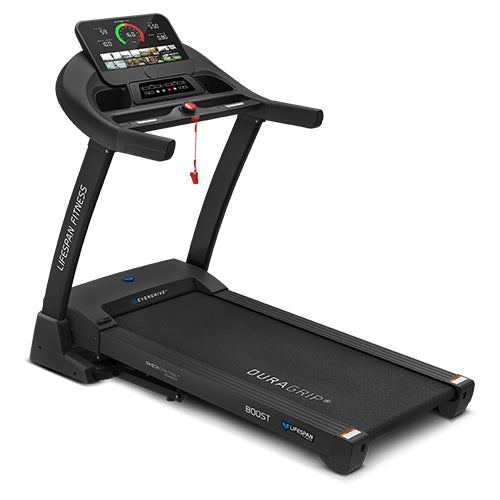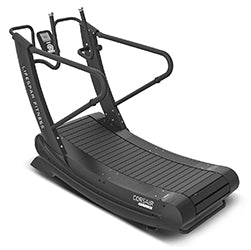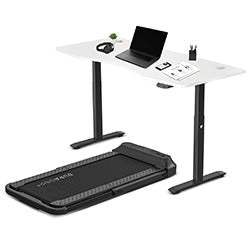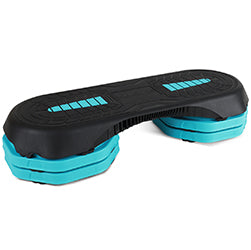

The treadmill is a classic piece of home fitness equipment, delivering a workout that is accessible and highly effective for so many people. But a treadmill's simplicity can be deceptive, and if you've never used a treadmill before, it's worth taking a second to learn the basics.
The main parts include the console, which houses the controls and display, the safety clip, the belt where you walk or run, and the incline settings. In this guide, we'll be breaking these components down, as well as giving you our best tips for safety on the treadmill.
By understanding your machine and taking a few precautions, you'll be enjoying all the incredible benefits treadmills have to offer in no time.
Ready, Set, Run
Before we're off and running, let's take a moment to understand how to begin your treadmill workout. Begin by familiarising yourself with the treadmill's basic functions. Before stepping onto the moving belt, stand on the side rails, not directly on the belt. Once you're ready, start the treadmill at a slow speed to get accustomed to the motion. Gradually increase the pace as you feel more comfortable.
Always start with a slow, controlled pace to avoid sudden jolts that can lead to injury. If you're new to treadmill workouts, spend a few minutes walking before transitioning to running. This warm-up phase helps your body adjust. Remember to maintain proper posture—keep your back straight, head up and arms relaxed at your sides. By starting slow and paying attention to your form, you can enjoy a safe and effective workout that builds your fitness and confidence.
Observe Occupancy Size

When setting up your treadmill, you want to make sure there's enough clearance around your treadmill. Ideally, you should have at least half a metre of space on each side of the treadmill and around 2 metres behind it. This clearance allows you to move freely and safely in case you need to step off the treadmill quickly or adjust settings during your workout.
Proper clearance helps prevent accidents. For example, if you need to grab a towel or water bottle, you can do so without risking injury or losing your balance. Having that buffer zone around the treadmill also reduces the risk of tripping over nearby objects.
Furthermore, having that space makes thing easier when you need to do maintenance or repairs. It allows for better ventilation, preventing the treadmill from overheating and ensuring a more comfortable workout environment.
Safety First with Safety Clip

The safety clip is a small but crucial component of treadmill safety. It's attached to the treadmill console with a cord and clips onto your clothing. If you stumble or fall, the clip pulls the key from the console, instantly stopping the treadmill to prevent further injury. Always use the safety clip, no matter how experienced you are with treadmill workouts. It acts as a safeguard, ensuring that the treadmill stops automatically if something unexpected happens, giving you that added peace of mind while you exercise.
Treadmill Warm Up Workout
Warming up before a treadmill workout is essential to prepare your muscles and joints, reducing the risk of injury and allowing you to get the most out of your workout. Here's a basic warm-up routine to follow:
- Gentle Walk (5 minutes): Start with a slow walk on the treadmill to gradually increase your heart rate and warm up your muscles. This helps your body transition smoothly from rest to activity.
- Dynamic Stretches (5 minutes): Step off the treadmill and perform dynamic stretches such as leg swings, high knees, and arm circles. These movements improve flexibility and mobilise your joints.
- Gradual Speed Increase (3 minutes): Return to the treadmill and increase the speed slightly, walking briskly for a few minutes. This further elevates your heart rate and prepares your body for more intense exercise.
- Incline Adjustments (2 minutes): If you plan to use the incline feature, adjust it to a moderate level and walk at a steady pace. This simulates the different intensities of your workout and engages various muscle groups.
- Light Jog (2-3 minutes): Finish your warm-up with a light jog to gradually increase your pace. This prepares your body for running or more vigorous exercise and ensures you're ready for your workout.
Stride The Belt

Straddling the treadmill belt correctly is essential for a safe and smooth start to your workout. Here are some tips on how to do it properly:
- Stand on the Side Rails: Before starting the treadmill, stand on the side rails, not on the moving belt. This allows you to get ready without the risk of slipping or stumbling.
- Secure Your Footing: Place one foot on the edge of the moving belt while keeping the other foot on the side rail. This helps you get used to the movement of the belt gradually.
- Step Onto the Belt Carefully: Once the treadmill is running at a slow speed, carefully step onto the moving belt with one foot, followed by the other. Ensure your footing is secure before adjusting the speed.
- Maintain Balance: Keep your arms extended slightly for balance and use the handrails for support if needed, especially when you first start.
Starting at a slow speed is crucial for a few reasons. It helps you get accustomed to the treadmill's motion and reduces the risk of losing your balance. It also allows your muscles and joints to gradually warm up, preventing strains and injuries. Starting slow provides an opportunity to adjust the treadmill settings, such as speed and incline, ensuring you can safely handle the changes.
Don't Look Down
One important point is to avoid looking down at your feet, as this can throw off your balance and strain your neck and back. Instead, keep your gaze forward, with your head up and shoulders relaxed. This posture helps you stay balanced and reduces the risk of injury. Focusing ahead also mimics the natural movement of walking or running outdoors, making your treadmill workout more effective and comfortable.
Keep Away from Children/Pets
The moving belt can be dangerous, especially for curious kids and pets who may not understand the risks. Keeping them in another room or securing the area around the treadmill ensures that you can focus on your workout without worrying about any unfortunate run-ins with little ones. This precaution not only protects your loved ones but also allows you to exercise without distractions.
One At a Time

When adjusting the treadmill settings, it's best to change one setting at a time. Whether you're increasing the speed or adjusting the incline, making one change at a time allows your body to adapt gradually. Rapid changes can throw off your balance or strain your muscles, increasing the risk of injury. By taking it slow and steady, you can maintain control over your workout and ensure a safer, more comfortable exercise session.
Your Own Pace, No Pressure
It's important to remember that everyone has their own fitness level, and there's no need to push yourself too hard right away. Start your treadmill workout at a pace that feels comfortable for you, gradually increasing intensity as your fitness improves. Rushing into a hardcore workout can lead to burnout or injury, especially if you're new to treadmill use. By listening to your body and progressing at your own pace, you can build endurance safely and enjoy your workouts more.
Conclusion

Now you have everything you need to enjoy your treadmill workout with total peace of mind. All that's left is get your workout gear on and get running!
By starting at a comfortable pace, using the safety clip and making gradual adjustments, you can give yourself the best chance of success.
Remember to maintain proper posture, keep distractions away and focus on one setting at a time. For more tips on finding the right treadmill for your space and budget, check out our guide. With these practices in mind, you'll be well on your way to a safe and effective treadmill workout.


















































